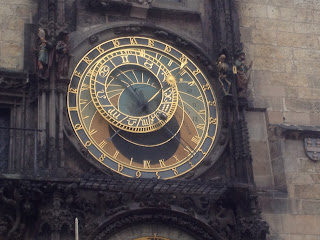Tuesday morning dawned cloudy and cold--nothing new there! We had asked our host if there was a good place to run near
his apartment, and he showed us a huge mausoleum at the top of a very huge hill and
told us that there was a running trail at the base of the hill. We decided to
give it a go, and, after piling on 3 or 4 layers of clothing, we set out on our
running adventure. We found the
trail just fine, but must have gone the wrong way at the fork in the road,
because we began to climb and found ourselves eventually up at the top of the
hill! The mausoleum was a big, rectangular chunk of a building—as far as we
could tell, at least part of it was a kind of Tomb of the Unknown Soldier. But
it was way cool to be at the top of the city (despite the clouds somewhat
spoiling the view), and the run down was much easier! After a shower and some
breakfast, we were ready to begin our day.
Today was the day dedicated to Prague Castle. It is a huge,
imposing complex, dominating the hill atop this beautiful city, and comprised
of the Palace itself, St. Vitus Cathedral, St. George’s Chapel and a number of
other buildings and courtyard areas.
Unfortunately it was still quite cold, and the buildings aren’t really
heated, but, other than that, the Castle Complex was well worth the entry fees!
After a brief stop in the courtyard, which holds the buildings where the
Archbishop and President live (as we left, there were definitely some very
official looking cars around the area…) we entered the exquisite St. Vitus
Cathedral. It was so beautiful! A Gothic Cathedral with all of its beauty, the
long nave leading to the altar, vaulted arches, everything you’d expect from a
cathedral of its time and importance. The stained glass windows were
particularly stunning, especially one by the famous Czech artist Alfons Mucha.
Rick Steves guided us with his usual attention to details and we learned more
than I expect to be able to retain about Czech church history. For example, Jan
Hus was a Czech Reformationist who was active about 100 years before Martin
Luther! He and his fellow Protestants (who were not yet officially
“Protestants,” instead they called themselves Hussites) tried to reform the
Catholic Church, and to get rid of many of the corrupt practices they had
instituted. While he was burned at the stake, about 200 years later, the
Protestants’ rebellion led to what was called the Defenstration of Prague—where
the Protestants actually threw the Catholics out the windows of the Castle, an
event which set off the 30 Years War.

 |
| The courtyard |
 |
| St. Vitus, too big to get into 1 photo! |
 |
| Mucha Window |
Also inside the cathedral were many tombs of Czech VIPs, including St. John of Nepomuk, whose tomb is supposed to have more than a ton of silver, and Good King Wenceslaus, of the Christmas Carol fame, whose tome has its own chapel in in the apse of the Cathedral.
 |
| Wenceslaus Tomb |
 |
| Hummel's tomb |
 |
| The "Golden Gate" |
After leaving the Cathedral, we entered the Royal Palace the seat of the Bohemian Princes starting the 12th Century. In this main hall, they have crowned the Czech kings from the 1400's until the last President of Czechoslovakia in the late 1990's. This hall is apparently so large because it needed to allow for indoor jousting! Another cool part of the palace was a set of side rooms that had coats
of arms painted on the ceiling. These coats of arms represented the
officials who worked there, and there was a nice little plaque
describing which belonged to which.
 |
| Windows of the "defenstration" |
 |
| View of the city from inside the castle |
 |
| St. George's Chapel |
 |
| St. George's Chapel |
 |
| Inside St. George |
The views from atop the castle hill were incredible—the
buildings with their red roofs and pastel-colored facades are so typical of
Prague. It retains its charm and elegance, because it was virtually untouched
during WWII. The
dungeon and torture room were pretty gruesome, and the restoration of the
residences of the castle workers really interesting and well preserved.
Outside the castle is "Golden Lane", a series of tiny houses which used to house castle servants and goldsmiths but now is part museum and part a lovely, quaint shopping street. The houses were actually occupied until right after WW II--Franz Kafka lived in one of the houses! Some of them are outfitted with paraphernalia representing the way they were in the Middle Ages, others are more modern, or have been turned into shops.
 |
| Golden Lane |
 |
| So cute! |
 |
| Kafka's house! |
 |
| Lobkowicz Palace |
After finishing at the castle complex, we walked back down
to the street that led back across the Charles Bridge to the Old Town Square
stopping at the Lennon Wall. During the Communist regime the drawings and
writing that people put on the wall after Lennnon’s death were erased or
painted over each night—since the fall of the regime, it has become a place to
write whatever you want—much of it commemorating the ideals of Lennon. We saw
the very, very underwhelming “show” at the Astronomical Clock on the hour (the
show was silly, but the clock is a true work of art and science) and enjoyed
the square itself with its churches and statues, especially the one
commemorating Jan Hus.

























































No comments:
Post a Comment